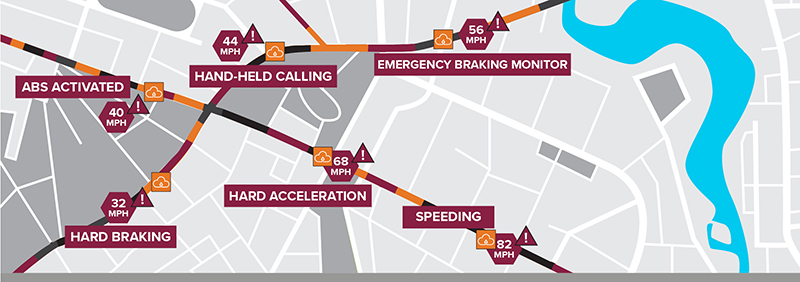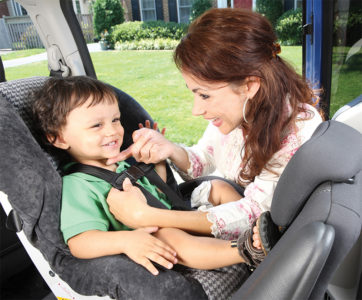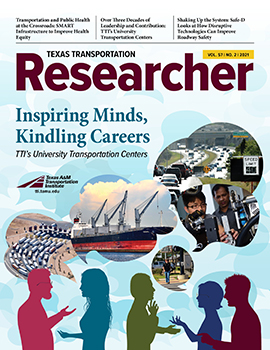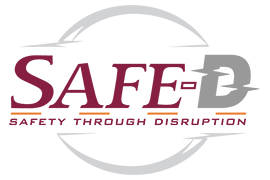Funded through the U.S. Department of Transportation’s University Transportation Center (UTC) Program, the Safety through Disruption (Safe-D) UTC is led by the Virginia Tech Transportation Institute (VTTI). In partnership with San Diego State University and the Texas A&M Transportation Institute (TTI), center researchers endeavor to maximize the potential safety benefits of disruptive technologies through targeted research that addresses the most pressing transportation safety issues.

Exploring How Connected Vehicle Data Enhance Crash Prediction Modeling
Knowing how many vehicles typically populate a road at peak travel periods is a key factor in many transportation planning and safety efforts, as is keeping track of how many crashes occur on a given roadway. Using data like these, traffic modeling can help predict the likelihood of crashes. Traffic modeling can also help identify locations with relatively higher risk for crashes as well as aid in selecting appropriate safety countermeasures to reduce and prevent them.
Funded by the Safe-D UTC, TTI researchers are currently working to enhance traditional crash prediction models, which rely heavily on physical road characteristics, the number of observed crashes in a location, and vehicle miles traveled. New data sets will allow crash models to include driving behaviors captured from sensors in newer-model connected vehicles (CVs) linked to the Internet.
“Our goal is to understand if these CV events, like hard braking, can serve as leading indicators of crashes so that we can more accurately predict high-risk locations before any crashes occur,” says TTI Assistant Research Scientist Michael Martin.
Purchased from Wejo (a data aggregation company), the data that cars routinely upload online provide researchers with information on travel speeds, seat belt usage, hard braking, and acceleration by date/time, location, and even the vehicles’ year, make, and model. Most of these types of information are closely related to the occurrence and severity of crashes but are not available from conventional safety data sets. Due to the detailed nature of these data, TTI researchers take extra precautions to ensure security and privacy.
“We are currently working with the TxDOT [Texas Department of Transportation] Odessa District in a number of test cases using these CV data in a real-world context,” Martin explains. “We’ve taken the Wejo data and aggregated the points, so we can easily see where people are driving and turning onto and off the highway — locations where we have a great deal of traffic conflicts caused by turning movements, slower speeds and vehicles stopping suddenly.”
“TTI’s connected vehicle and IVMS [in-vehicle monitoring system] research has been especially useful in the Permian Basin because of the rate at which oil well pads and proppant plants come online,” says Odessa District Engineer John Speed. “It allows us to quickly and accurately assess traffic behavior and update roadway construction plans to provide safe movements at driveways and intersections. And even during construction, TTI applied CV data to isolate hard-braking locations and turning movements for vehicles approaching a major project, providing our engineers with a new range of tools for improving traffic safety.”
Collaborative Study Examines Child-Seat Usage in Rideshare Services, Reveals Lack of Knowledge and Awareness

A 2019 Safe-D project conducted collaboratively by VTTI and TTI reveals a deeper understanding of how riders, drivers and the public view issues surrounding transporting children via rideshare services such as Uber and Lyft. Results highlight the importance of education and outreach on safety issues associated with the practice.
The research team first performed an in-depth review of the child passenger safety regulatory literature and laws across the United States. Regulations were often difficult to find; involved multiple statutes; and were sometimes confusingly worded, vague or unclear about the responsibilities of riders and drivers of rideshare vehicles.
“We discovered a wide variety of differences in child restraint requirements across the country,” says TTI Senior Research Scientist Katie Womack, the Institute’s project lead, “and very little that directly and specifically relates to requirements for car-seat use in rideshare vehicles.”
The team also conducted a series of focus groups with rideshare riders and drivers, as well as a nationwide Internet survey aimed at assessing riders’ and drivers’ knowledge and attitudes toward child passenger safety. In general, the focus groups revealed parents’ commitment to using car seats in their own vehicles. However, the impracticality of using their personally owned seats, along with other limiting factors and knowledge, generally resulted in failure to use car seats for rideshare trips.
Rideshare drivers in the focus group shared a general lack of knowledge regarding their responsibility in the car-seat equation and indicated a preference for not advising parents on issues regarding whether, when or how to secure their children in the vehicle. Most of the drivers participating in the focus group were unaware of the requirements of the Texas law on child safety seat use or if/how it pertained to them when transporting children. There was wide consensus that the training rideshare drivers receive from their service companies was minimal, and the company policies were unclear.
“This research study is a first step in identifying major issues surrounding child-seat usage in rideshare services,” VTTI Research Scientist Justin Owens says. “As alternatives to traditional transportation grow in popularity, child passenger safety advocates, traffic safety professionals, researchers, lawmakers and industry partners must continue to educate, regulate, advocate and innovate for child safety in every vehicle.”

